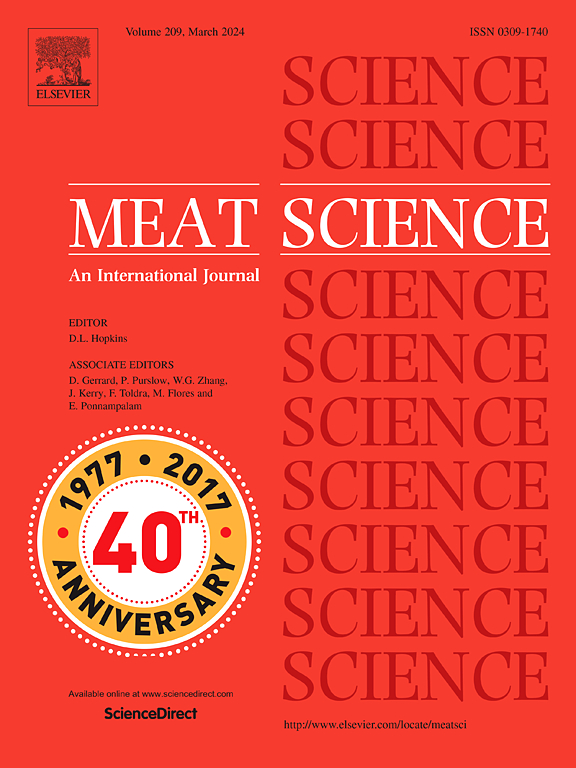Effect of NaCl reduction and/or replacement on the quality and safety of dry-fermented sausages: Systematic review and meta-analysis
IF 6.1
1区 农林科学
Q1 Agricultural and Biological Sciences
引用次数: 0
Abstract
Sodium chloride (NaCl) is a key ingredient in the production of dry-fermented sausages. However, as a response to the need of healthier foods, several studies have evaluated the effects of reducing or replacing NaCl in sausages. The present systematic review and meta-analysis aimed to evaluate and quantify the influence of NaCl reduction and/or replacement on microbiological and physicochemical parameters of dry-fermented sausages. A systematic review was carried out in databases according to selection criteria and search strategies established a priori. The literature search yielded 549 citations and 43 scientific articles with 99 experiments, which were included in the meta-analysis. A random-effects model was used to estimate the pooled weighted mean difference with a 95 % confidence interval. Pool estimation showed that NaCl reduction and/or replacement in dry-fermented sausages increased moisture, water activity, redness (a* value), lactic acid bacteria count, and tyramine content (P = 0.002, P < 0.001, P = 0.002, P < 0.001, P = 0.001, P = 0.001 and P = 0.001, respectively), but decreased lightness (L* value), the Staphylococci count and the textural parameter resilience (P = 0.012, P = 0.014 and P < 0.001, respectively). Subgroup analysis indicated that the factors with the greatest influence on the microbiological and physicochemical parameters of dry-fermented sausages were: NaCl reduction or replacement, the type of salt used in the replacement, and the NaCl percentage in the control and treatment groups. While NaCl reduction alone causes several changes in the parameters evaluated, replacement with alternative salts helps mitigate these effects. The safety of sausages with NaCl reduction and/or replacement was not compromised, as Enterobacteriaceae did not grow, compared to conventional sausages.
NaCl还原和/或替代对干发酵香肠质量和安全的影响:系统评价和荟萃分析
氯化钠(NaCl)是生产干发酵香肠的关键原料。然而,作为对健康食品需求的回应,一些研究评估了减少或替代香肠中NaCl的效果。本系统综述和荟萃分析旨在评价和量化NaCl还原和/或替代对干发酵香肠微生物学和理化参数的影响。根据先验建立的选择标准和搜索策略在数据库中进行系统评价。文献检索产生了549次引用和43篇科学文章,包含99个实验,这些都被纳入了meta分析。随机效应模型用于估计合并加权平均差,置信区间为95%。池估计表明,在干发酵香肠中,NaCl的减少和/或替代增加了水分、水分活度、红度(a*值)、乳酸菌数量和酪胺含量(P = 0.002, P <;0.001, P = 0.002, P <;(P = 0.001, P = 0.001, P = 0.001和P = 0.001),但降低了亮度(L*值)、葡萄球菌数量和质地参数弹性(P = 0.012, P = 0.014和P <;分别为0.001)。亚组分析表明,对干发酵香肠微生物和理化参数影响最大的因素是:NaCl还原或替代、替代盐的种类、对照组和处理组的NaCl百分比。虽然单独的NaCl还原会导致评估参数的一些变化,但用替代盐替代有助于减轻这些影响。与传统香肠相比,NaCl还原和/或替代香肠的安全性没有受到影响,因为肠杆菌科细菌没有生长。
本文章由计算机程序翻译,如有差异,请以英文原文为准。
求助全文
约1分钟内获得全文
求助全文
来源期刊

Meat Science
工程技术-食品科技
CiteScore
12.60
自引率
9.90%
发文量
282
审稿时长
60 days
期刊介绍:
The aim of Meat Science is to serve as a suitable platform for the dissemination of interdisciplinary and international knowledge on all factors influencing the properties of meat. While the journal primarily focuses on the flesh of mammals, contributions related to poultry will be considered if they enhance the overall understanding of the relationship between muscle nature and meat quality post mortem. Additionally, papers on large birds (e.g., emus, ostriches) as well as wild-captured mammals and crocodiles will be welcomed.
 求助内容:
求助内容: 应助结果提醒方式:
应助结果提醒方式:


